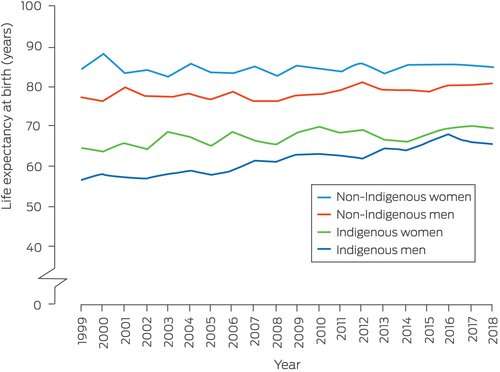Life expectancy at birth for Indigenous and non-Indigenous people in the Northern Territory, 1999–2018, by sex. Credit: Medical Journal of Australia (2022). DOI: 10.5694/mja2.51553
Life expectancy increased more rapidly for Indigenous than non-Indigenous people in the Northern Territory (NT) between 1999 and 2018, but the gap remains considerable, say the authors of research published today by the Medical Journal of Australia.
"To quantify progress in the NT towards the Closing the Gap target of eliminating the difference in life expectancy between Indigenous and non-Indigenous Australians by 2031, we have prepared updated life expectancy estimates for the NT for the period 1999–2018," wrote the authors, led by Dr. Yueyen Zhao, Principal Health economist at the NT Department of Health and Families.
"We also quantified the contributions of changes in years of life lost to specific disease groups to overall changes in life expectancy, in order to identify areas in which progress has been achieved."
Zhao and colleagues analyzed data from the Australian Coordinating Registry on underlying and nine multiple causes of death (ICD-10) for deaths in the NT, by age, sex, and Indigenous status, 1 January 1999–31 December 2018.
"Life expectancy for Indigenous men increased from 56.6 years in 1999 to 65.6 years in 2018 and from 64.8 to 69.7 years for Indigenous women," they reported.
"For non-Indigenous people, it increased from 77.4 to 81.0 years for men, and from 84.3 to 85.1 years for women.
"Increased life expectancy for Indigenous men was primarily linked with fewer years of life lost to cancer (23% of overall change), unintentional injuries (18%), and cardiovascular disease (17%), and for Indigenous women with fewer life years lost to cancer (24%), intentional injuries (17%), and kidney disease (14%).
"During 1999–2018, the difference in life expectancy between Indigenous and non-Indigenous people declined by 26% for men (from 20.8 to 15.4 years) and 21% for women (from 19.5 to 15.4 years).
"Our findings increase our knowledge of life expectancy changes during 1999–2018 for Indigenous and non- Indigenous people in the NT.
"Our analysis is the first to compare the details of these changes in life expectancy in both populations, and to identify the disease groups in which progress has been made, such as cancer and other chronic conditions.
"Mental health care and the social determinants of health, focuses of the Closing the Gap program, remain challenges," Zhao and colleagues concluded.
More information: Yuejen Zhao et al, Improved life expectancy for Indigenous and non‐Indigenous people in the Northern Territory, 1999–2018: overall and by underlying cause of death, Medical Journal of Australia (2022). DOI: 10.5694/mja2.51553
Journal information: Medical Journal of Australia
Provided by Medical Journal of Australia (MJA)























